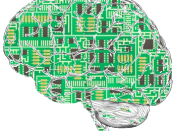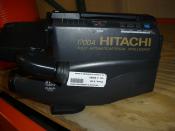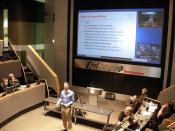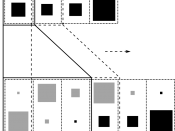Work on AI began in the 1950's with researchers wanting to use a computer to model the way a human thinks. This new field quickly took off, but had difficulties due to the inability to produce anything that really resembled human intelligence.
Artificial intelligence is defined as the ability of a machine to think for itself.
Scientists and theorists continue to debate if computers will actually be able to think for themselves at one point (Liebowitz). The generally accepted theory is that computers will think and do more in the future. AI has grown rapidly in the last ten years chiefly because of the advances in computer architecture. The term artificial intelligence was actually coined in 1956 by a group of scientists having their first meeting on the topic (Liebowitz). Early attempts at AI were neural networks modeled after the ones in the human brain. Success was minimal because of the lack of computer technology needed to calculate such large equations.
AI is achieved using a number of different methods. The more popular implementations comprise of neural networks and fuzzy logic. Using any one of the aforementioned design structures requires a specialized computer system.
Computer systems may require greater speeds using super computers or workstations.
Even more exotic is the software that is used. Since there are very few applications that are pre-written using AI, each company has to write it's own software for the solution to the problem. An easier way around this obstacle is to design an add-on." (Barron 111) In order to tell that AI is present we must be able to measure the intelligence being used. For a relative scale of reference, large supercomputers can only create a brain the size of a fly. It is surprising what a computer can do with that intelligence once it has been put to work. The neural network tries to mimic the way a brain and nervous system work by analyzing sensory inputs and calculating an outcome. A neural network is usually composed of simple decision making elements that are connected with variable weights and strengths. Each one these elements is called a neurode. The term neurode is similar to the biological neuron. The term was modified slightly to indicate an artificial nature. Memory is stored by a certain pattern of the connection weights between the neurodes.
Before the network can be used a neural network must be trained. Some can learn by themselves, neural networks require training by doing, and others learn by trial and error. Additionally, a computer can retrieve stored information from incomplete or partially incorrect clues. Neural networks are able to generalize categories based on specifics of the contents. Lastly, it is highly fault tolerant. This means that the network can sustain a large amount of damage and still function. Its performance fades proportionally as the neurodes disappear. This type of system is inherently an excellent design for any application that requires little human intervention and that must learn on the go.
The Military has been able to harness this intelligence and center it into a highly advanced computer system allowing for the largest leap in reaching Artificial Intelligence. Over the years, the ever increasing and expanding research on Artificial Intelligence, particularly in the field of Military defense, has seen the development and implementation of many commercial and industrial applications that utilize the link between the theory of AI and the military. The advances of AI in the military have seen the development of expert missiles and combat training. However all these systems hold a great weight on their ability to make a large impact on the increase of world safety. This is why the development of AI and the implementation of human-like qualities has finally been used, to increase the intelligence of a "computer" to have its own responses. Robotics is the first and probably the most advanced way to harness AI.
Generation 5 is the most advanced military based robot to come out of the research on Artificial Intelligence by the military. Generation 5 stands for the fifth step in the robotic advances. The generation 5 robot has been "programmed" to speak, have its own personal responses and act accordingly in dangerous circumstances. This, according to the military is the largest leap in the history of robotics. No one person, has been able to have a machine generate its own particular responses to a command. This highly developed technology is just one aspect that makes up a human.
The Generation 5 project was designed to decrease the need for humans on the battle field. The heavy chance of invasion or warfare on another country is likely today and there is great demand to lower the casualties that often occur when war breaks out.
The Generation 5 project has many advanced feature. With the capability of hand to hand combat, and the ability for long range battle, the Generation 5 project is capable to perform any task in a war situation. The Generation 5 robot also allows for large amounts of camouflage, making it very capable of infiltrating any site. The Generation 5 robot is also capable of making its own decisions in battle e.g. if it should hide, if it should fire, or if it should call for back-up. The main aim of the project was to make it react like a human in warfare, given that choices have to be made. With the limited amount of information on how to make an Artificial human, it is obvious that there will be a vast amount of negatives. Some of these include the possibility of the possibility of a wrong decision made by the robot, a malfunction or vital intelligence being given away to warring countries.
However the positives easily outweigh the negatives.
Home appliances win most of the ground with AI enhanced washing machines, vacuum cleaners, and air-conditioners. Hitachi and Mitsubishi manufactures washing machines that automatically adjust for load size and for dirt levels in the clothes. This machine washes until clean, not just for ten minutes. Mitsubishi also manufactures vacuum cleaners that adjust the suction power according to the volume of dust and the type of flooring. Lastly, Mitsubishi uses fuzzy logic to gradually slow air-conditioners to the desired temperature. Which reduces the power consumption is reduced by 20%.
In conclusion, AI is a very useful technology that human society should not be without. AI was created in the 1950's and since then has progessed to levels that were only science fiction in the 1950's. AI is based on huge computer networks that "learn" by weighing different outcomes of situations. AI is used in the military field for defence and strategic battles. AI is being put in fighter jets and tanks. AI also has a place in homes and in cars, everything from checking how dirty your clothes in, to what condition your car's lights are in.





